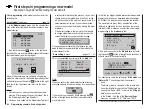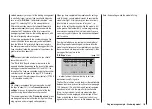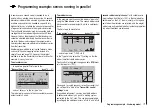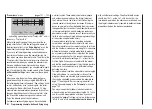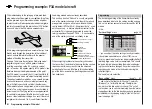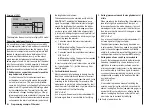
178
Programming example: delta and flying wing
On page 164, where the section on fixed-wing model
programming starts, you will find general notes regard-
ing the installation and set-up of the RC system in a
model, and - of course - this applies equally to deltas
and flying wings. The information on test-flying and refin-
ing the settings is also relevant, including the section on
programming flight phases.
left
right
In their characteristic shape and geometry, deltas and
flying wings differ very significantly from “normal” models
even at first sight, but the differences in the requisite
servo arrangement are rather more subtle. The “clas-
sic” model delta or flying wing generally has only two
control surfaces, which act both as ailerons (in opposite
directions) and as elevators (in the same direction), in a
similar way to the superimposed rudder / elevator func-
tions of a V-tail. More modern designs tend to be more
complex; one (or two) inboard control surfaces may be
used purely as elevators, while the outboard ailerons
also act as elevators, but to a reduced extent. If a flying
wing has four or even six wing control surfaces, it is
certainly feasible nowadays to set them up with camber-
changing flap functions and / or even a butterfly (crow)
system.
However, most of these models still rank as “classic” del-
tas and flying wings, and for them the servos should be
connected to the receiver as follows (see also page 62):
Airbrakes or throttle or speed
controller (electric motor)
Right flap
Left flap
Rudder (if present)
Left elevon (ail. / elev.) servo
Right elevon (ail. / elev.) servo
Auxiliary function
Auxiliary function
Receiver power supply
If your delta or flying wing is of more “modern” configura-
tion, the “normal” servo sequence has proved useful;
this arrangement can also be used for canards:
Airbrakes or throttle or speed
controller (electric motor)
Right flap (/ elevator)
Left flap (/ elevator)
Rudder (if present)
Left elevon (aileron / elevator)
Elevator (if present)
Right elevon (aileron / elevator)
Auxiliary function
Receiver power supply
Depending on the receiver servo sequence you select,
you should first move to the …
“Base settings”
menu
… and select the following options in the line “
motor at
C1
”:
“none”:
•
The brake system is “retracted” at the
forward
posi-
tion of the throttle / brake stick; the “Ch8 delayed” op-
tion and the “Brake
NN*” mixers in the “
Wing mi-
xers
” menu are
activated
.
In the “Aileron / flap” line of the “
Basic settings
”
menu you can select “1AIL”, “2AIL” and “1/2AIL
Programming example: Delta / flying wing
1/2FL”, and in the “
Wing mixer
” menu the mixer
“Brake
NN*”, plus all mixers “from” and “to” flaps,
are
activated
.
The warning message “Throttle too high” - see pages
36 and 67 - and the “Motor stop” option in the “
Basic
settings
” menu are
disabled
.
“none/inv”:
•
The brake system is “retracted” at the
back
position
of the throttle / brake stick; the “Ch8 delayed” option
and the “Brake
NN*” mixers in the “
Wing mixers
”
menu are
activated
.
In the “Aileron / flap” line of the “
Basic settings
”
menu you can select “1AIL”, “2AIL” and “1/2AIL
1/2FL”, and in the “
Wing mixer
” menu the mixer
“Brake
NN*”, plus all mixers “from” and “to” flaps,
are
activated
.
The warning message “Throttle too high” - see pages
36 and 67 - and the “Motor stop” option in the “
Basic
settings
” menu are
disabled
.
“Idle forward” or “Idle rear”
•
The Ch 1 trim operates either forward or back.
If you switch the transmitter on with the throttle stick
too far in the direction of full-throttle, you will see the
warning message “Throttle too high” on the screen.
In the “
Basic settings
” menu the “Motor stop” option
is
activated
. In the same menu the “Ch8 delayed” op-
tion and the “Brake
NN*” mixers in the “
Wing mi-
xers
” menu are disabled.
“tail type”:
“Delta / flying wing” or “Normal”
“aile/flap”:
Two ailerons “2ail” and - if present -
two flaps “2fl”.
The primary function of these settings is to define the
* NN = Nomen Nominandum (name to be stated)
Summary of Contents for mx-12 Hott
Page 1: ...Programming Manual 33116 mx 16 HoTT 3 en mx 16...
Page 35: ...35 For your notes...
Page 49: ...49 For your notes...
Page 55: ...55 For your notes...
Page 59: ...59 For your notes...
Page 63: ...63 For your notes...
Page 69: ...69 For your notes...
Page 91: ...91 For your notes...
Page 101: ...101 For your notes...
Page 123: ...123 For your notes...
Page 181: ...181 For your notes...
Page 193: ...193 For your notes...



